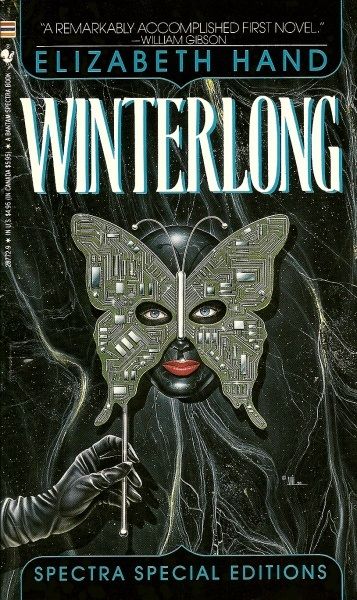And Rain Keeps Falling Like Helpless Tears
Winterlong (Winterlong Trilogy, volume 1)
By Elizabeth Hand

15 Jan, 2018
Elizabeth Hand’s 1990 debut novel Winterlong is the first volume in her Winterlong Trilogy.
Nuclear war and germ warfare have left Washington a shadow of its once glorious past. A handful of administrators, descended from self-appointed curators, control the relics of America’s lost past, defending the remnants from the diseased, mutated, and simply unlucky inhabitants of the surrounding sea of ruins.
A desperate woman appealed to House Miramar for refuge. Too damaged to be of use to Miramar, the woman was cast out to die at the hands of the lazars. But Miramar did keep her two beautiful children, as new Paphians for Miramar’s bordellos. Only Raphael proved suitable. Autistic Wendy Wanders was consigned to HEL.
The Human Engineering Laboratory’s experimental procedures kill most of their subjects. Wendy not only survived, she gained remarkable empathic abilities. This made her a potentially useful diagnostic and therapeutic tool. But as a recent string of suicides indicates, she is also potentially deadly. Not everyone survives contact with Wendy.
The most recent suicide brings HEL to the attention of NASNA (which is … apparently a wider realm that treats Washington as a protectorate; no further info is given in the book). NASNA is stuck for a way to suitably reward Aviator Margalis Tast’annin, glorious hero of the Archipelago Conflict. Dispatching him to take charge of HEL and the rest of Washington is a perfect solution, because the Aviator will be far too busy to bother the autocrats.
The arrangement is less than satisfactory from Wendy’s perspective, since the Aviator will almost certain execute most of the staff at HEL, preserving its changelings only long enough to extract from them any weaponizable potential useful in the coming war with the Balkhash Commonwealth. With almost certain death facing her if she stays, Wendy flees in the company of Justice, a visiting prostitute, who is much taken with her.
Raphael, Wendy’s brother, has his own problems, not least of which is his unfortunate habit of inadvertently killing people with a deadly weapon given to him by a well-meaning acquaintance. He is already yearning for freedom; the deaths finally nudge him into absconding and seeking his fortune outside the House of Miramar.
Wendy Wanders becomes Aiden the actor, whose similarity to Raphael is often remarked. Raphael’s trail of corpses earn him the title of the Gaping One, an incarnation of death. Together they become crucial playing pieces for the increasingly demented Aviator, whose time in Washington has gone poorly for him. Gone are his political and military ambitions. Now, all that remains for the former war hero is orchestrating the end of the world.
~oOo~
The Washington of several centuries hence is a lush, rotting fruit whose rulers are mainly interested in exploiting those weaker for anything they can extract from them. HEL’s carefree attitude towards human experimentation is typical. So too is the rampant sexual exploitation of children, which provides a good chunk of House Miramar’s income. House Miramar might argue that they’re only doing the best they can to keep as many of their charges alive as possible … but their business practices produce a lot of corpses. Few subjects of House Miramar see their third decade.
Piecing together exactly what led to this world is difficult because the characters are often ignorant and their teachers mostly ill-informed
The Pilgrims. They came over the ocean in airships, fleeing the Old World where they were persecuted. They built the great monuments in the City in memory of their homeland. The Sorrowful Lincoln, the Obelisk, the Library of Conquest.
Those who do know their history are fond of allusive references, to a degree that John M. Ford would admire. What is clear is this is a world ruled by contending autocrats, of whom the North American examples are far from the most powerful. Eurasia’s Balkhash Commonwealth carries out raids within NASNA territory at will; NASNA’s determination to strike back is almost certainly a suicidal failure to comprehend the balance of power.
What does seem clear is that this isn’t a sustainable world. Each cycle of destruction and recovery preserves the tools of war but little else. Each new high is lower than the one before, despite the beauty of their weapons. Populations are a shadow of what they were, which at least raises the hope the whole world system will collapse below the point needed to produce WMDs.
Reminiscent of Tanith Lee at her most decadent and Gothic, this book was a lot more engaging than one would expect from a novel about two abused kids in a world that is ruled by malevolent autocrats, dotted with ruins populated by homicidal victims of biological warfare, and fond of ethics-free genetic engineering.
Winterlong is available here (Amazon) and here (Chapters-Indigo).
